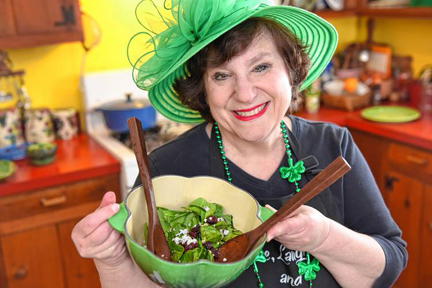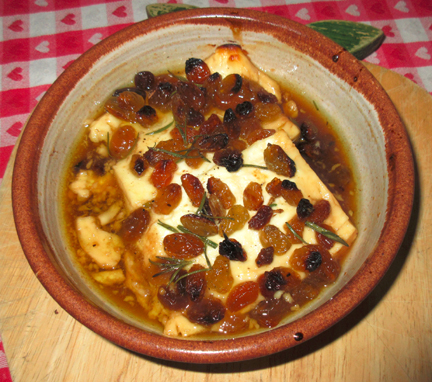
March is Massachusetts Maple Month. Farmers in my area are working more or less around the clock to turn the sap that flows from maple trees in spring into the sweet elixir that New Englanders prize year round.
This coming weekend, March 16-17, is Massachusetts Maple Weekend, and members of the Massachusetts Maple Producers Association have a number of celebrations planned.
Every time I drive to Greenfield these days, I pass a sign at Hager’s Farm Market luring me with the promise of fried dough topped with maple cream on Saturday. I am trying to resist temptation!
Fortunately, most of my own culinary uses for maple syrup do not involve the extreme sweetness of fried dough or even pancakes. I love to use maple to add a slight sweetness to foods like salad dressings, coleslaw, pork, and even (as you’ll see below) cheese.
I also love to contemplate maple’s place in American history. Colonists learned of its sweet bounty from Native Americans; in early colonial times, maple syrup and sugar were significantly less expensive than imported sugar from cane.
Benjamin Rush (1746-1813), a prominent Pennsylvania physician and scholar who was among the signers of the Declaration of Independence, promoted maple over cane sugar not because of maple’s price but because of its means of production. Cane sugar was made by slaves, and Rush was an abolitionist.
Other abolitionists took up the cause of maple. Thomas Jefferson, who despite his own slave holdings opposed slavery in principle, fell in love with the idea of maple as an alternative to cane sugar as well.
“What a blessing,” he wrote in 1790, “to substitute a sugar which requires only the labour of children, for that which it is said renders the slavery of the blacks unnecessary [sic].”
My local maple sugarers could have told Jefferson that successful sugar production requires labor from more than children, but his heart was in the right place. He believed that maple production was a perfect occupation for the “yeoman farmer” he saw as the American ideal.
The sugar maples Jefferson planted at Monticello died; the climate of southern states proved dicey for producing maple syrup.
As sugar became less and less expensive over the decades, even hardy New Englanders (unless they were strict abolitionists) changed over to cane sugar as their primary sweetener. Maple was increasingly viewed as it is today: as an expensive and highly prized specialty food.
Maple played a part again in American history in the early 20th century in the campaign that led to the Pure Food and Drug Act of 1906. Maple syrup was among the products for which many false claims were made before manufacturers were held accountable by that law.
C.C. Regier noted in a 1933 article, “More than ten times the amount of Vermont maple syrup was sold every year than that state could produce.” Happily, if something is labeled “pure maple syrup” today, the labeling is accurate.
I am are lucky to live in an area where I can purchase pure maple syrup from neighbors and visit working sugarhouses. The photo above shows me getting ready for Saint Patrick’s Day with my beloved maple vinaigrette. (Thanks to Paul Franz at the Recorder for the festive picture!)
One of my current favorite maple recipes comes from the Massachusetts Maple Producer Association. I would never have thought of pairing feta cheese with maple, but the combination is wonderful!
I made it recently on Mass Appeal, along with my Irish Cottage Soda Bread. Here is the feta recipe—and of course the videos are below.
Happy Saint Patrick’s Day to all, and happy maple season!

I like to serve this sweet-and-savory cheese dish with homemade crostini I make with small, store-bought baguettes.
To prepare the crostini, I slice the bread thinly, rub it with a minimal amount of olive oil on each side, and sprinkle salt on one side. I then bake the crackers for 10 to 15 minutes in a preheated 350-degree oven, turning them once.
Ingredients:
2 tablespoons extra-virgin olive oil
1 6-ounce block feta cheese (it’s hard to find a 6-ounce block; use part of a larger block if necessary)
1/4 cup golden raisins
a generous helping of fresh rosemary
freshly ground pepper
1/4 cup maple syrup
Instructions:
Preheat the oven to 425 degrees. Drizzle half of the olive oil in the bottom of a small baking dish. (I use a brie baker from the potter Jeanne Douillard of Greenfield, Massachusetts.)
Cut the feta so that it is relatively thin and covers most of the surface of the baker. Sprinkle the raisins, rosemary leaves, and pepper over all; then top with the maple syrup and the remaining oil.
Bake until everything is bubbly and one or two raisins are starting to burn. This process can be tricky; you don’t want your dish to blacken, but you do want the cheese to soften.
Let the mixture cool slightly before serving it with crackers or crostini. Serve it with a spoon, and make sure that each little helping gets a bit of everything: cheese, raisins, rosemary, and juice. This cheese dish may also be served on the side of a green salad. Serves 4 to 6.
And now the videos!
Tinky Makes Irish Cottage Soda Bread


